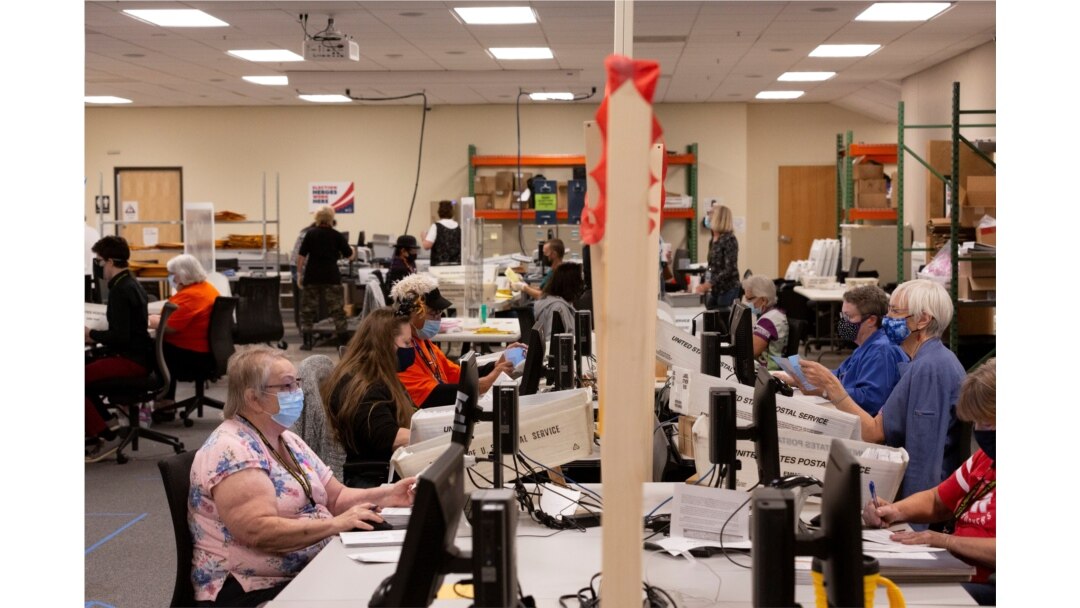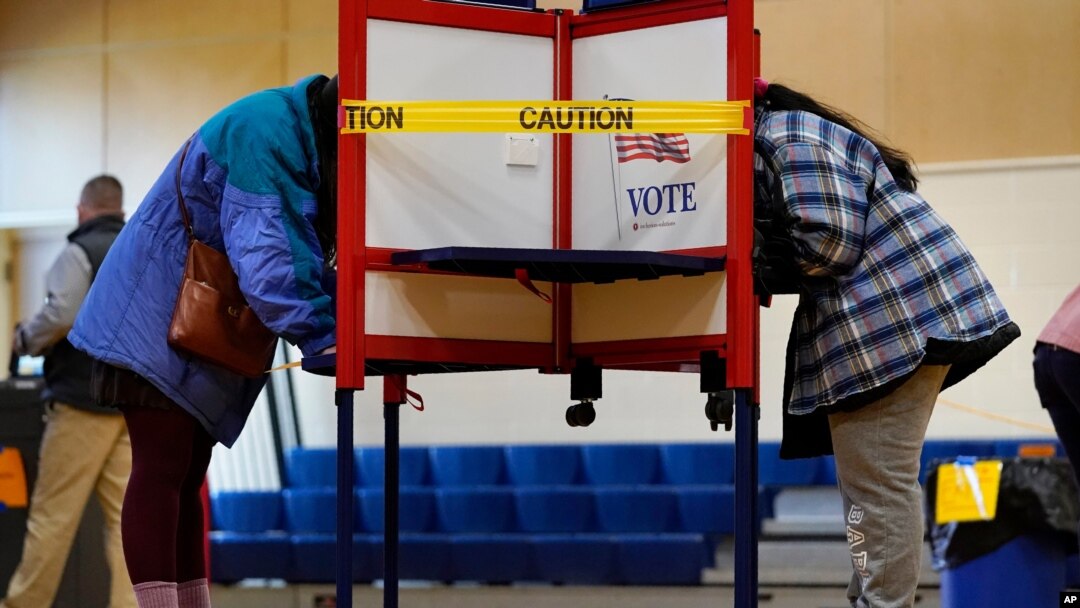A grueling, bitterly fought U.S. presidential campaign comes to a close Tuesday.
Tens of millions of voters are casting ballots to help decide whether to keep incumbent Republican President Donald Trump as the country’s chief executive for the next four years or oust him in favor of his Democratic challenger, former Vice President Joe Biden.
Latest developments
- Polls are open throughout the United States.
- Biden began Election Day by attending Mass at a Delaware church, and later speaking to supporters in nearby Philadelphia, Pennsylvania.
- Trump started the morning by calling the “Fox & Friends” program and then visited his reelection headquarters in Arlington, Virginia, outside Washington, before returning to the White House.
- Election officials in Franklin County, the most populous in Ohio, said Tuesday it switched to paper poll books to check in voters after glitches in its electronic check-in system. The glitches did not affect voting machines.
- The U.S. Postal Service said there were delays in delivering ballots to election officials in the battleground state of Michigan and in parts of the key states of North Carolina and Pennsylvania. They must be delivered Election Day in Michigan and must be postmarked by Election Day in North Carolina and Pennsylvania to count.
- The U.S. Elections Project, which tracks early voting, said about 638,000 ballots had not been returned to Pennsylvania election officials by November 2. The project said about 476,000 ballots in Michigan had not been delivered by that date.
- Acting Homeland Security Secretary Chad Wolf told reporters Tuesday morning there is “no indication” that a “foreign actor” has successfully interfered in the election.
Record early voting
Amid the coronavirus pandemic in the U.S., more than 101 million people cast early ballots — more than two-thirds of the entire vote count in the 2016 election when Trump upset Democrat Hillary Clinton to win the White House.

Early voting and absentee ballots are processed ahead of the upcoming presidential election in Tucson, Arizona, Oct. 31, 2020.
With the heavy early voting, the total 2020 vote count, by some estimates, could reach a U.S. record of 150 million or more. But with state-by-state laws controlling how soon the absentee votes can be counted — not until Tuesday night or later in some states — the outcome of the election may not be known for days, depending on how close the contest turns out.
The presidential election is coming after a rancorous and combative campaign, with both Republican leader Trump and Democratic Party challenger Biden lobbing taunts, claiming the other is unfit to lead the country and would take it to ruination.
Over the weekend, tensions mounted as thousands of Trump campaign supporters rallied and demonstrated throughout the country, in one case forcing a Biden campaign bus off a highway in Texas with a caravan of vehicles bearing Trump flags, and also tying up traffic on a New Jersey parkway.
SEE ALSO: FBI Probing Trump Caravan Confrontation with Biden Campaign Bus in TexasAuthorities and merchants in some cities, including New York and Washington near the White House, have boarded up storefronts to prevent potential damage and looting in the event election-related violence erupts.
Men walk past an eatery boarded up in advance of Election Day, Nov. 2, 2020, near the White House in Washington.
Many of the early voters — two-thirds of whom mailed in ballots while the rest cast votes in person — said they wanted to avoid coming face to face Tuesday with other people in long lines at polling stations, as the U.S. on some recent days has recorded more than 90,000 new coronavirus cases.
In the meantime, some Democrats said they wanted to be among the first to vote against Trump, to make him the third U.S. president in the last four decades to be defeated after a single term. Many Republicans said they planned to vote in person on the official presidential Election Day — the first Tuesday after the first Monday in November — as has been the norm in U.S. elections every four years since the mid-1800s.
Voters are choosing between two septuagenarians, both of them older than the vast majority of the country’s 328 million citizens. Biden will be 78 by Inauguration Day on January 20, while Trump is 74. Whoever wins will be the oldest U.S. leader ever.
In addition, voters are choosing all 435 seats in the House of Representatives and 35 of the 100 seats in the Senate.
President Donald Trump arrives for a campaign rally at Wilkes-Barre Scranton International Airport, Nov. 2, 2020, in Avoca, Pennsylvania.
Trump
The president, in the waning days of the campaign, has called the election “a choice between the American Dream and a socialist nightmare. … A choice between a Trump super-recovery and a Biden depression.”
Trump has claimed that Biden, if elected, would be beholden to the policy proposals of more progressive Democrats who are pushing for a government takeover of U.S. health care and a Green New Deal to control climate change, both of which the moderate Biden says he opposes.
Trump has repeatedly claimed that the U.S., with a world-leading coronavirus death toll of more than 231,000 people and 9.2 million infections, according to Johns Hopkins University, is “rounding the corner” in dealing with the pandemic, and promises that within weeks, the U.S. will have a vaccine against the coronavirus.
“I watched Joe Biden speak yesterday,” Trump said Saturday. “All he talks about is COVID, COVID. He’s got nothing else to say. COVID, COVID.”
FILE - Certified nursing assistant (CNA) Jermaine LeFlore prepares to take a patient's nasal swab at a drive-thru testing site outside the Southside Health Center in Milwaukee, Wisconsin, Oct. 21, 2020.
Biden
Biden has often assailed Trump’s handling of the virus.
Biden told one rally, “Millions of people out there are out of work, on the edge” because of the pandemic. “Can't see the light at the end of the tunnel, and Donald Trump has given up. Donald Trump has waved the white flag, abandoned our families and surrendered to the virus.”
Democratic presidential candidate former Vice President Joe Biden speaks at a rally at Community College of Beaver County, Nov. 2, 2020, in Monaca, Pennsylvania.
Biden said he would “choose hope over fear. We choose unity over division. Science over fiction. And yes, we choose truth over lies.”
“I don’t care how hard Donald Trump tries. There’s nothing — let me say that again — there’s nothing that he can do to stop the people of this nation from voting in overwhelming numbers and taking back this democracy,” Biden said at a rally in Flint, Michigan.
Electoral voting
National polls have for weeks shown Biden leading Trump nationally by about 7 or 8 percentage points, but only by about half that margin or less in key battleground states that are likely to determine the outcome.
The U.S. employs an indirect form of democracy, not a national popular vote, to pick its leaders. The outcome is effectively decided in state-by-state elections throughout the 50-state country and the national capital city, Washington, D.C.
The winner needs a 270 majority in the 538-member Electoral College. In all but two of the states, either Trump or Biden will win all the electors from an individual state by winning the popular vote there, with the most populous states holding the most electors.
Two lightly populated states — Maine in the Northeast with four electoral votes and Nebraska in the Midwest with five — award their electors by the outcome in individual congressional districts and the overall statewide vote, which could be a factor in an extremely close election.


